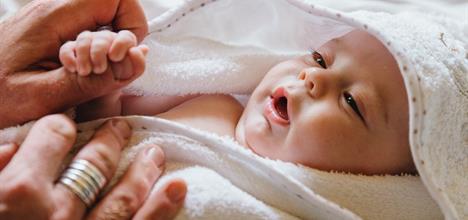Newborn Baby Navel Clip Breaks Off in 5 Days
Ages & Stages
Bathing Your Infant


Page Content
By: Dipesh Navsaria, MPH, MSLIS, Medico, FAAP
Bathing your babe is an feel many parents treasure. It'south a keen time to bond, distraction-complimentary, equally your tiny new family member enjoys the sensation of warm water on their skin. Still this common parenting ritual oftentimes comes with questions, and sometimes anxiety, about when and how to do it well.
Hither are some frequently asked questions from parents almost topics related to babe bath timing, frequency, safety, and more.
When should newborns get their outset bath?
The timing of your baby'due south very first bath has changed over the last few years. While most institutions used to bathe babies within an hour or two of birth, many are irresolute their policies.
The Globe Health System (WHO) recommends delaying infant's commencement bath until 24 hours after birth—or waiting at least 6 hours if a total twenty-four hour period isn't possible for cultural reasons.
Why wait? |
|---|
Note: Babies of mothers with HIV or the Hepatitis viruses will still be bathed after the initial breastfeed in order to decrease risk to hospital staff and family members.
How oftentimes do babies need a bath once they are home?
Newborns don't need a bathroom every day. They rarely sweat or go dirty plenty to demand a total bath that often.
3 baths per week during babe's first year may be enough. Bathing more oftentimes can dry out your baby's skin.
Tin my baby have a bath before the umbilical cord falls off?
Merely give your newborn sponge baths until the stump of the umbilical cord falls off, which usually happens past about 1 or two weeks of age. If it remains beyond that time, at that place may be other bug at play. See the babe's doctor if the cord has not dried upward and fallen off by the time the infant is 2 months old. Larn more here.
How to give a sponge bath
A sponge bathroom is like a regular bath, except yous don't put your baby in the h2o.
Baby sponge bath prophylactic tips:
|
|---|
When is my baby ready for a regular bathroom?
Once the umbilical area is healed, you tin endeavor placing your infant directly in the water. His first baths should be as gentle and brief equally possible. He may protest a little. (If this happens become dorsum to sponge baths for a calendar week or two, and so try the bathroom once more). Babies commonly go far clear when they're fix.
Baby bathtub safety tips:
|
|---|
Recollect…
Knowing the basics tin make bathing your infant a breeze. Merely make sure your infant stays comfortable and prophylactic during bath fourth dimension―and don't forget to soak up all the special moments that come with it!
Boosted Data:
-
Babe Water Safety: Protect Your New Baby from Drowning
-
5 Bathroom Safety Tips for Infants & Immature Children
-
Baby Birthmarks & Rashes
Almost Dr. Navsaria:
 Dipesh Navsaria, MPH, MSLIS, Dr., FAAP is an acquaintance professor of pediatrics at the University of Wisconsin School of Medicine and Public Wellness and is director of the MD–MPH programme there. He has practiced primary intendance pediatrics in a variety of settings and is the founding medical director of Accomplish Out and Read Wisconsin. Dr. Navsaria regularly writes op-eds on wellness-related topics, does radio and telly interviews, and frequently speaks locally, regionally and nationally on early brain and kid development, early literacy, and advocacy to a broad diversity of audiences. Follow him on Twitter @navsaria, Facebook, and visit his website www.navsaria.com.
Dipesh Navsaria, MPH, MSLIS, Dr., FAAP is an acquaintance professor of pediatrics at the University of Wisconsin School of Medicine and Public Wellness and is director of the MD–MPH programme there. He has practiced primary intendance pediatrics in a variety of settings and is the founding medical director of Accomplish Out and Read Wisconsin. Dr. Navsaria regularly writes op-eds on wellness-related topics, does radio and telly interviews, and frequently speaks locally, regionally and nationally on early brain and kid development, early literacy, and advocacy to a broad diversity of audiences. Follow him on Twitter @navsaria, Facebook, and visit his website www.navsaria.com.
Article Body
- Last Updated
- iii/3/2020
- Source
- American University of Pediatrics (Copyright © 2019)
The information contained on this Web site should not exist used as a substitute for the medical intendance and advice of your pediatrician. There may exist variations in treatment that your pediatrician may recommend based on individual facts and circumstances.
Source: https://healthychildren.org/English/ages-stages/baby/bathing-skin-care/Pages/Bathing-Your-Newborn.aspx
0 Response to "Newborn Baby Navel Clip Breaks Off in 5 Days"
Post a Comment